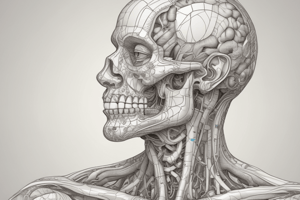Podcast
Questions and Answers
What is responsible for moving food from one part of the alimentary canal to the next?
What is responsible for moving food from one part of the alimentary canal to the next?
- Sphincters
- Mucosa
- Digestive juices
- Peristalsis (correct)
Which part of the digestive system contains tiny glands that produce juices to help digest food?
Which part of the digestive system contains tiny glands that produce juices to help digest food?
- Small intestine (correct)
- Mouth
- Stomach
- Liver
What is the main function of the digestive organs?
What is the main function of the digestive organs?
- Helping in respiration
- Regulating body temperature
- Producing energy for the body's cells (correct)
- Producing red blood cells
Which organ is responsible for producing digestive juices that reach the intestine through small tubes known as ducts?
Which organ is responsible for producing digestive juices that reach the intestine through small tubes known as ducts?
What is the name of the process that converts waste into excretable material in the digestive system?
What is the name of the process that converts waste into excretable material in the digestive system?
What is the main function of the lymphatic system?
What is the main function of the lymphatic system?
What is the composition of lymph fluid?
What is the composition of lymph fluid?
Where does lymph fluid drain into before reaching the lymph nodes or glands?
Where does lymph fluid drain into before reaching the lymph nodes or glands?
What is the role of lymphocytes and monocytes carried by lymph fluid?
What is the role of lymphocytes and monocytes carried by lymph fluid?
How do lymph capillaries form lymph vessels?
How do lymph capillaries form lymph vessels?
What is the main function of saliva in the digestive system?
What is the main function of saliva in the digestive system?
What is the role of the pharynx in the digestive process?
What is the role of the pharynx in the digestive process?
What is the function of the oesophagus in the digestive system?
What is the function of the oesophagus in the digestive system?
What is the primary purpose of peristalsis in the digestive system?
What is the primary purpose of peristalsis in the digestive system?
What is the function of digestive juices in the digestive system?
What is the function of digestive juices in the digestive system?
Flashcards
What is Peristalsis?
What is Peristalsis?
Wave-like muscle contractions that move food through the digestive tract.
What is the Small Intestine?
What is the Small Intestine?
Contains glands that produce juices aiding in food digestion and nutrient absorption.
Main Function of Digestive Organs
Main Function of Digestive Organs
To provide the body's cells with the energy they need to function.
What is the Pancreas?
What is the Pancreas?
Signup and view all the flashcards
What is Excretion?
What is Excretion?
Signup and view all the flashcards
Main Function of the Lymphatic System
Main Function of the Lymphatic System
Signup and view all the flashcards
Composition of Lymph Fluid
Composition of Lymph Fluid
Signup and view all the flashcards
Where Lymph Fluid Drains
Where Lymph Fluid Drains
Signup and view all the flashcards
Role of Lymphocytes and Monocytes
Role of Lymphocytes and Monocytes
Signup and view all the flashcards
How Lymph Capillaries Form Vessels
How Lymph Capillaries Form Vessels
Signup and view all the flashcards
Main Function of Saliva
Main Function of Saliva
Signup and view all the flashcards
Role of the Pharynx
Role of the Pharynx
Signup and view all the flashcards
Function of the Oesophagus
Function of the Oesophagus
Signup and view all the flashcards
Primary Purpose of Peristalsis
Primary Purpose of Peristalsis
Signup and view all the flashcards
Function of Digestive Juices
Function of Digestive Juices
Signup and view all the flashcards
Study Notes
Digestive System
- Muscular contractions and relaxations, known as peristalsis, are responsible for moving food from one part of the alimentary canal to the next.
Digestive Organs
- The main function of the digestive organs is to break down food into smaller molecules that can be absorbed and utilized by the body.
Pancreas
- The pancreas is the organ responsible for producing digestive juices that reach the intestine through small tubes known as ducts.
Small Intestine
- The small intestine contains tiny glands that produce juices to help digest food.
Absorption and Excretion
- The process that converts waste into excretable material in the digestive system is known as absorption.
Lymphatic System
- The main function of the lymphatic system is to defend the body against disease-causing organisms and to aid in the removal of waste products.
Lymph Fluid
- Lymph fluid is composed of water, salts, sugars, fats, and proteins.
- Lymph fluid drains into the lymphatic vessels before reaching the lymph nodes or glands.
Lymphocytes and Monocytes
- Lymphocytes and monocytes carried by lymph fluid play a crucial role in defending the body against disease-causing organisms.
Lymph capillaries
- Lymph capillaries merge to form larger lymph vessels, which eventually drain into the bloodstream.
Saliva
- The main function of saliva in the digestive system is to break down carbohydrates into simple sugars.
Pharynx
- The pharynx plays a crucial role in the digestive process by facilitating the passage of food from the mouth to the oesophagus.
Oesophagus
- The oesophagus is a muscular tube that uses peristalsis to propel food into the stomach.
Peristalsis
- The primary purpose of peristalsis in the digestive system is to mix food with digestive enzymes and to move it through the alimentary canal.
Studying That Suits You
Use AI to generate personalized quizzes and flashcards to suit your learning preferences.




